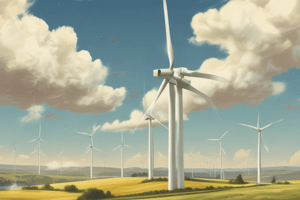Podcast
Questions and Answers
What is Solar Power?
What is Solar Power?
- Converts underground heat to energy.
- Uses the movement of water caused by tides for energy.
- Uses turbines to generate energy.
- Converts sunlight to energy using photovoltaic cells. (correct)
What is Wind Power?
What is Wind Power?
- Generates energy using turbines. (correct)
- Creates reservoirs.
- Converts sunlight to energy.
- Uses tides to generate energy.
What is Hydroelectric Power?
What is Hydroelectric Power?
- Converts sunlight to energy.
- Generates energy using wind.
- Converts movement of water into energy. (correct)
- Uses nuclear reactions.
What is Tidal Power?
What is Tidal Power?
What is Energy?
What is Energy?
What does Kinetic Energy refer to?
What does Kinetic Energy refer to?
What does Potential Energy depend on?
What does Potential Energy depend on?
The Law of Conservation of Energy states that energy can be created and destroyed.
The Law of Conservation of Energy states that energy can be created and destroyed.
What does a wind turbine do?
What does a wind turbine do?
What is a generator?
What is a generator?
The freezing point of Celsius is _____ degrees.
The freezing point of Celsius is _____ degrees.
The boiling point of Fahrenheit is _____ degrees.
The boiling point of Fahrenheit is _____ degrees.
What does the term Biomass refer to?
What does the term Biomass refer to?
Study Notes
Energy Sources
- Solar Power: Converts sunlight to energy using photovoltaic cells; costly and less effective in poor weather.
- Wind Power: Generates energy through turbines; can be visually unappealing and less reliable in extreme heat.
- Hydroelectric Power: Utilizes water movement to produce energy with turbines; can create reservoirs that may cause ecological issues.
- Tidal Power: A form of hydroelectric power leveraging tidal movements; generally produces limited energy.
- Geothermal Power: Extracts underground heat for energy; restricted to regions with high tectonic activity.
Energy Concepts
- Energy: The capacity to perform work.
- Work: Defined as the force applied to an object over a distance.
- Kinetic Energy: Energy possessed by a moving object.
- Potential Energy: Energy related to an object's position, particularly in relation to gravitational force.
- Law of Conservation of Energy: Energy cannot be created or destroyed, only converted into different forms.
Temperature Scales
- Celsius: Water freezes at 0°C and boils at 100°C.
- Fahrenheit: Water freezes at 32°F and boils at 212°F.
- Kelvin: Absolute temperature scale, where freezing is at 273.15 K and boiling at 373.15 K.
- Rankine: Similar to Kelvin but aligned with Fahrenheit; 0°R is absolute zero and is always 459.67 degrees higher than °F.
Electrical Concepts
- Electricity: Movement of electrons; creates charge that can be harnessed for work.
- Voltage: Electrical pressure that drives current, measured in volts.
- Electric Current: Rate at which electric charge (electrons) moves through a circuit, measured in amperes.
- Watt: Standard metric unit for power, representing energy transfer rate.
- Ohm's Law: Relates voltage, current, and resistance.
Mechanics of Wind Power
- Windmill: A device utilizing wind's kinetic energy for mechanical work.
- Wind Turbine: Converts wind's mechanical energy to electricity.
- Rotor: Composed of turbine blades and hub, essential for energy capture.
- Nacelle: Enclosure at turbine's top housing generator and drivetrain components.
- Gearbox: Connects low-speed shaft to the high-speed shaft; increases turbine rotation speed for electricity generation.
Wind Power Components
- Blade Pitch: The angle of turbine blades affecting their interaction with wind.
- Anemometer: Measures wind speed, vital for turbine performance.
- Controller: Activates wind turbine operations based on wind speed; ensures safety at high winds.
- Brake System: Mechanically halts rotor for emergency situations.
Electrical Components in Power Plants
- Generator: Converts mechanical energy from wind into electrical energy.
- Resistance: Material's opposition to charge flow, affecting circuit performance.
- Diode: Permits current flow in one direction, functioning as a one-way valve.
Alternative Energy and Environmental Impact
- Alternative Energy: Energy sources with minimal environmental harm; includes solar, wind, and hydro.
- Biofuel: Produced from recently living biological material; distinct from fossil fuels.
- Biomass: Organic material used for fuel or production, encompassing plant and animal matter.
Miscellaneous Concepts
- Calorie: The amount of heat needed to raise the temperature of 1 kg of water by 1°C.
- Conduction and Convection: Methods of heat transfer; conduction involves direct contact, while convection relies on fluid movement.
- Turbine Efficiency Variables: Factors impacting turbine performance include blade length, pitch, and aerodynamics.
U.S. Electricity Generation (2014 Data)
- Coal: 38.8%
- Natural Gas: 27.4%
- Nuclear: 19.5%
- Renewables: 13.2%
- Other: 1.2%
Studying That Suits You
Use AI to generate personalized quizzes and flashcards to suit your learning preferences.
Description
This quiz covers key concepts related to various forms of energy including solar, wind, and hydroelectric power. Each card provides definitions and insights into the advantages and disadvantages of each energy source. Perfect for students preparing for the Science Olympiad.





